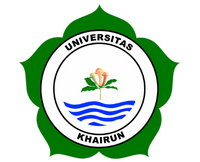Biological Aspects of Keperas Fish (Cyclocheilichthys apogon) in Batutegi reservoir, Tanggamus Regency, Lampung Province
Abstract
The research aims to analyze several biological aspects of the squeezed fish in Batutegi Lampung Reservoir. The study used an experimental method of capture used net capture tool with mesh-size 1.5-2.5 inches. Sample fish measured their total length, weighed in weight, and examined their stomachs to determine what type of food they had. We researched in February, August, and November 2017. The example of keperas fish caught amounted to 415 individuals. Analysis of long-weight relationships showed that February and August were allometrically negative, while November allometric was positive. The condition factor is worth one at each station and month. The eating habits of squeezed fish are plants 50%, fish 15%, insects 10%, worms 9%, phytoplankton 8%, and zooplankton 8%. The growth pattern of fish squeeze in November is isometric and allometric positive due to the development of gonads. The food habits of fish keperas are omnivorous, with the composition according to food availability in the environment.
Keywords
Full Text:
PDFReferences
Effendie, M.I. 1997. “Biologi Perikanan”. Yogyakarta: Yayasan Pustaka Nusantara.
Effendie, M.I. 1979. “Metoda Biologi Perikanan”. Bogor: Yayasan Dewi Sri.
Kottelat M., A.J. Whitten, S.N. Kartikasari and S. Wirjoatmodjo. 1993. “Freshwater Fishes of Western Indonesia and Sulawesi”. Hongkong: Periplus.
Kottelat M. and Widjanarti. 2005. “The Fishes of Danau Sentarum National Park and the Kapuas Lakes area, Kalimantan Barat, Indonesia”. Raffles Bull. Zool. Supplement. Vol. 13 page 139-173.
Lagler, K.F., J.E. Bardach, R.R. Miller, and D.M. Passino. 1977. “Icthyology”. New York: Jhon Willey dan Sons. Inc.
Rainboth W.J. 1996. “Fishes of The Cambodian Mekong. FAO species identification field guide for fishery purposes”. Rome: FAO.
Sarnita A.S. 1999. “Introduction and Stocking of Freshwater Fishes Into Inland Waters of Indonesia. In. Fish and fisheries of lakes and reservoirs in Southeast Asia and Africa”. West Yorkshire, UK: Westbury Publishing.
Steel R.G.H. and J.H. Torrie. 1989. “Prinsip dan Prosedur Statistika: Suatu Pendekatan Biometrik (Diterjemahkan oleh Bambang Sumantri) edisi kedua”. Jakarta: Gramedia.
Taki Y. 1978. “An Analytical Study of The Fish Fauna of The Mekong Basin as a Biological Production System in Nature. Japan: Research Institute of Evolutionary Biology Special Publications.
Talwar P.K., and A.G. Jhingran. 1991. “Inland Fishes of India and Adjacent Countries. Rotterdam: Balkema.
Vidthayanon C. 2002. “Peat Swamp Fishes of Thailand”. Bangkak, Thailand: Office of Environmental Policy and Planning.
Walpole R.V.E.1993. “Pengantar Statistik. Terjemahan Bambang Sumantri (edisi tiga)”. Jakarta: Gramedia.
Yap S.-Y. 1988. Food Resource Utilization Partitioning of Fifteen Fish Species at Bukit Merah Reservoir, Malaysia. Hydrobiologia Vol. 157 page 143-160.
Yuniarti I. 2004. Reproduksi Ikan Baji-baji (Grammooplites scaber) (Linnaeus, 1758) di Perairan Pesisir Mayangan, Subang, Jawa Barat. Skripsi Fakultas Perikanan dan Ilmu Kelautan Institut Pertanian Bogor (IPB). Bogor: IPB.
DOI: https://doi.org/10.32502/jgsa.v1i2.3188
Refbacks
- There are currently no refbacks.
Indexed by:
Journal of Global Sustainable Agriculture
Diterbitkan oleh Fakultas Pertanian, Universitas Muhammadiyah Palembang
Contact Person:
Rika Puspita Sari, M.Si (+62 813-7490-0341)
Klinik Publikasi Pertanian
Faculty of Agriculture, Universitas Muhamamdiyah Palembang
JL. Jend. A. Yani 13 Ulu Palembang, South Sumatra, Indonesia
Tel. (+62)711-511731; Email: kppfpump@gmail.com; Website: https://jurnal.um-palembang.ac.id/JGSA

This work is licensed under a Creative Commons Attribution 4.0 International License.







1.png)

13.png)





